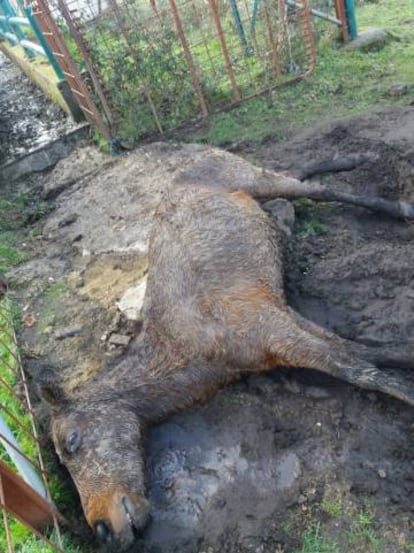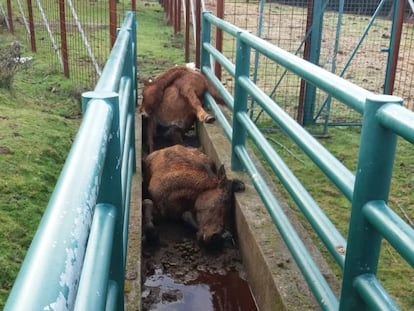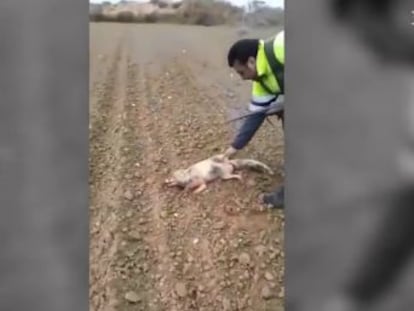Galicia searches for killers of four wild horses
The endangered animals were found dead with blows to the head in a deworming corridor

The largest zoomorphic petroglyph of the Iberian Peninsula, located in the archaeological zone Outeiro dos Lameiros (in the municipality of Baiona), depicts 78 horses, all walking toward an enclosure. Three of the animals are mounted by humans, who lived in the area 4,000 years ago. The scene depicted is remarkably similar to the Rapa das Bestas festival in Galicia, a tradition that involves cutting the manes of these wild horses.

On the other side of Baiona, four kilometers south of the Galician municipality, is Alto da Groba. The mountain, which hides behind a thick blanket of fog, is home to one of the most important populations of wild horses in Galicia. The genetic code of these animals, known as Garrano, can be traced back to the Pleistocene period – an epoch which dates back to 11,700 years – and are ancestors of the modern-day horse. In the 1970s, around 20,000 Garranos lived in the area, but today it is estimated that only a fifth of the population remains.
Last week, a group of people familiar with the area climbed the mountain, pushed nine Garranos into a deworming corridor for cattle, closed the latches, and beat four of them to death using an iron bar. Five of the horses were supposedly saved because a noise spooked the attackers. Seprona, the Civil Guard’s nature protection service, is currently looking for the criminals, but they are not optimistic about finding them – those with information are likely to “fear starting problems” with such violent people.
The brutal killing took place in the municipality of Oia, in the northwestern Spanish region of Galicia, where today only 750 Garranos remain. At the end of the 20th century, 2,000 lived in the area. On the first two Sundays in June, farmers from five municipalities (Baiona, Oia, Gondomar, Tomiño and O Rosal) gather the horses and corral them into large pens called curros, in Torroña and Mougás (Oia) where they are dewormed, shaved and marked. Some, especially males and colts, are sold for meat. The rest of the year, the horses live in herds among trees and feed on the pulp from toxos, a thorny bush that covers the Galician mountains.
The females are kept alive for breeding purposes, and about 250 foals are born each year. The “grandmother” of the area gave birth to a total of 24 foals, and died last year after her last delivery. However, these numbers barely make up for the number of Garranos that die each year because of the lack of food at the beginning of winter.
An animal rights group is offering a reward of €500 to anyone with information on the killing
“We don’t fix anything by feeding them because there are 300 cows in the area that eat everything,” explains Modesto Domínguez, president of the Monte da Groba Horse Association. “The cows control the area, because they have horns.”
In a desperate search for information on the brutal killing of the four mares, the Baño Miño Nature Association (Anabam), in collaboration with the Community of Montes de Viladesuso, has promised confidentiality and a reward of €500 for anyone who can provide information on what happened. Francisco Fernández Marugán, the acting ombudsman, has opened an ex-officio investigation and is demanding that the Galician regional government “protect the Garranos, which is a species in danger of extinction.”
According to veterinarians who inspected the animals’ bodies, one of the mares died immediately, while two resisted and tried to fight. The fourth was badly beaten but remained alive, suffering in the rain for five days. The attack is thought to have happened between Wednesday and Thursday of last week. When the mares were found on Sunday, the fourth was still breathing, but could barely move more than her ears.
“She had dry eyes. She was left brain dead from the blows,” said the president of the Horseman’s Association, which is made up of the 82 owners of the 750 wild horses. Domínguez is particularly attached to wild horses – he can go on the mountain and recognize each of his mares through the fog. He even has names for each one: Careta, Baia, Ubre Pinta, Ubre Branca...
Only 750 Garranos remain in Oia. At the end of the 20th century, 2,000 lived in the area
The Garrano, despite having had owners for thousands of years, is considered a wild animal. Each horse is branded, and now, due to a 2012 decree issued by the Department of Rural Environment, must also be microchipped. Owners of wild horses in Galicia strongly opposed the measure, arguing the expense would be too great. The conflict evolved into a long legal battle with the last appeal from two livestock associations reaching the Human Rights Court in Strasbourg last September. When the decree passed, the cost of a microchip was €40 and a Garrano, a small animal whose commercial value is based on its weight alone, was around €100. Today the microchip costs €16, but there are areas in Galicia where farmers still resist microchipping their horses, and where regulations allow the City Halls to send any Garrano without a microchip to the slaughterhouse.
In the Serra de Groba, ranchers oppose the microchip, but have complied with the decree and implanted them in the younger Garranos. When the killed mares were found, a microchip reader was passed over their necks to identify them and determine their owners. The mares belonged to four different people from different municipalities of the region, which rules out the theory that the killing was a matter of personal revenge. After the culprits fled, the mare that suffered for several days kicked down one of the metal doors that kept the animals trapped in the deworming corridor.
Because the animals were squeezed into the corridor one after the other, the five Garranos that managed to avoid being beaten were trapped behind the bodies of the other four and unable to escape. The youngest mare was 14 months old, and the oldest was 10 years old.
English version by Asia London Palomba.
Tu suscripción se está usando en otro dispositivo
¿Quieres añadir otro usuario a tu suscripción?
Si continúas leyendo en este dispositivo, no se podrá leer en el otro.
FlechaTu suscripción se está usando en otro dispositivo y solo puedes acceder a EL PAÍS desde un dispositivo a la vez.
Si quieres compartir tu cuenta, cambia tu suscripción a la modalidad Premium, así podrás añadir otro usuario. Cada uno accederá con su propia cuenta de email, lo que os permitirá personalizar vuestra experiencia en EL PAÍS.
¿Tienes una suscripción de empresa? Accede aquí para contratar más cuentas.
En el caso de no saber quién está usando tu cuenta, te recomendamos cambiar tu contraseña aquí.
Si decides continuar compartiendo tu cuenta, este mensaje se mostrará en tu dispositivo y en el de la otra persona que está usando tu cuenta de forma indefinida, afectando a tu experiencia de lectura. Puedes consultar aquí los términos y condiciones de la suscripción digital.
More information
Archived In
Últimas noticias
Maduro pleads not guilty before the federal court in New York: ‘I am still the president of Venezuela’
A new test can detect Alzheimer’s from a finger prick
UN team enters Sudanese city of El Fasher after paramilitary massacre: ‘It’s like a ghost town’
A recipe for resistance: Indigenous peoples politicize their struggles from the kitchen
Most viewed
- Gilles Lipovetsky: ‘If you want to live better and fall in love, take Prozac, don’t look to philosophy’
- Alain Aspect, Nobel laureate in physics: ‘Einstein was so smart that he would have had to recognize quantum entanglement’
- Alvin Hellerstein, a 92-year-old judge appointed by Bill Clinton, to preside over Maduro’s trial in New York
- Maduro’s downfall puts China’s relationship with Venezuela to the test
- Why oil has been at the center of Venezuela-US conflicts for decades










































